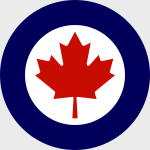Hobby Master HA4326 RCAF North American Sabre Mk.6 Jet Fighter - 23622, 430 Squadron, RCAF Station North Bay, Canada, 1950s (1:72 Scale)
"I tried to get some of the men to trade with me -- I'm not on the schedule today -- but with weather like this, they know there are MiGs up there near the Yalu. No one was willing to trade his mission for my day off."
- Major James P. Hagerstrom
 The first swept-wing airplane in the U.S. fighter inventory, the F-86 scored consistent victories over Russian-built MiG fighters during the Korean War, accounting for a final kill ratio of 10-to-1. Interestingly, all 39 United Nations jet aces won their laurels in Sabres. Four models of the plane (F-86A, E, F and H) were designated day fighters or fighter bombers, while the F-86D, K and L versions were touted as all-weather interceptors. Successive models of the daylight versions - all designed to destroy hostile aircraft in flight or on the ground - were equipped with more powerful engines and armament systems that ranged from iron bombs and rockets to machine guns and cannon. The three interceptor versions, on the other hand, were equipped with black radome noses, replacing the yawning jet intakes of the other models.
The first swept-wing airplane in the U.S. fighter inventory, the F-86 scored consistent victories over Russian-built MiG fighters during the Korean War, accounting for a final kill ratio of 10-to-1. Interestingly, all 39 United Nations jet aces won their laurels in Sabres. Four models of the plane (F-86A, E, F and H) were designated day fighters or fighter bombers, while the F-86D, K and L versions were touted as all-weather interceptors. Successive models of the daylight versions - all designed to destroy hostile aircraft in flight or on the ground - were equipped with more powerful engines and armament systems that ranged from iron bombs and rockets to machine guns and cannon. The three interceptor versions, on the other hand, were equipped with black radome noses, replacing the yawning jet intakes of the other models.
The F-86F featured an uprated engine and a larger "6-3" wing without leading-edge slats. A total of 2,239 were built; North American model NA-172 (F-86F-1 through F-15 blocks), NA-176 (F-86F-20 and -25 blocks), NA-191 (F-86F-30 and −35 blocks), NA-193 (F-86F-26 block), NA-202 (F-86F-35 block), NA-227 (first two orders of F-86F-40 blocks comprising 280 aircraft that reverted to leading-edge wing slats of an improved design), NA-231 (70 in third F-40 block order), NA-238 (110 in fourth F-40 block order), and NA-256 (120 in final F-40 block order); 300 additional aircraft in this series assembled by Mitsubishi in Japan for Japanese Air Self-Defense Force. Sabre Fs had much improved high-speed agility, coupled with a higher landing speed of over 145 mph (233 km/h). The F-35 block had provisions for a new operational role: the tactical nuclear attack utilizing newer, smaller, and lighter nuclear weapons ("second generation" nuclear ordnance). The F-40 had a new slatted wing with a slightly higher span, resulting in a slight decrease in speed, but also much better agility at both high and low speeds and a reduced landing speed of 124 mph (200 km/h). The USAF upgraded many previous F versions to the F-40 standard. One E and two Fs were modified for improved performance via rocket boost.
Pictured here is a 1:72 scale replica of a RCAF North American Sabre Mk.6 Jet Fighter that was attached to 430 Squadron during the 1950s.
Pre-order! Ship Date: June 2025.
Dimensions:
Length: 6-3/4-inches
Wingspan: 6-1/4-inches
Release Date: ?
Historical Account: "Swiftly and Surely" - No. 430 Squadron RCAF was a unit of the Royal Canadian Air Force formed during World War II as the "City of Sudbury" squadron in 1943. Initially created as an army co-operation squadron, 430 was re-designated as a fighter reconnaissance unit later that year. The unit was stationed in England, France, Belgium, the Netherlands, and Germany, and flew photo reconnaissance missions in support of planning for the Normandy landings. After D-Day, missions included before-and-after photography of attacks on V-1 flying bomb launch sites and support for ground forces. 430 Squadron was disbanded in Germany in August 1945.
In the Cold War period, the squadron was reformed in November 1951 at RCAF Station North Bay, flying the Canadair F-86 Sabre. It was given the nickname Silver Falcon. 430 Fighter Squadron went to 2 Wing RCAF Station Grostenquin near Grostenquin, France in September 1952. The squadron was located at Grostenquin until deactivation in September 1962.
430 Fighter Squadron was reactivated at 3 Wing Zweibrucken, West Germany, in February 1963, and transitioned to the Canadair CF-104 Starfighter. The squadron moved to 1 Wing Lahr, West Germany in February 1969 until it was disbanded in May 1970.


